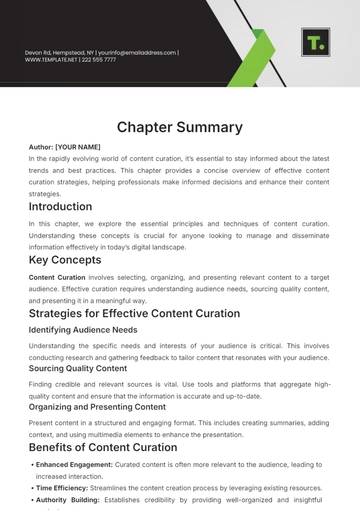Free Clinical Trials Chapter Outline

Prepared By: [Your Name]
1. Introduction to Clinical Trials
A. Definition and Purpose
Clinical trials are research studies conducted with human participants to evaluate the safety and efficacy of medical interventions. They aim to generate data to support or refute hypotheses about new treatments or procedures.
B. History and Evolution
The concept of clinical trials dates back to ancient times, but modern clinical trials began to take shape in the 20th century with the development of randomized controlled trials (RCTs). Landmark studies like the Framingham Heart Study (1948) significantly advanced the field.
C. Importance in Medical Research
Clinical trials are critical for advancing medical knowledge and developing new therapies. They provide evidence on the effectiveness and safety of treatments, which is essential for regulatory approval and clinical practice.
2. Types of Clinical Trials
A. Interventional Trials
Randomized Controlled Trials (RCTs)
These trials randomly assign participants to either the treatment group or control group to compare outcomes. For instance, the landmark study on the effectiveness of the COVID-19 vaccines involved RCTs to assess their efficacy in preventing infection.
Non-Randomized Trials
These include cohort studies where participants are assigned to groups based on pre-existing characteristics. An example is a trial comparing outcomes in patients receiving standard care versus an experimental treatment without random assignment.
B. Observational Trials
Cohort Studies
Researchers follow a group of people over time to assess the impact of exposures or interventions. For example, a cohort study might track the long-term health effects of exposure to a specific environmental pollutant.
Case-Control Studies
These studies compare individuals with a condition (cases) to those without it (controls) to identify potential risk factors. For example, a case-control study might explore the association between smoking and lung cancer.
Cross-Sectional Studies
These studies assess data from a population at one point in time to determine prevalence and correlations. An example is a survey to measure the prevalence of diabetes in a given community.
C. Experimental vs. Non-Experimental Trials
Experimental trials involve testing new treatments, while non-experimental trials observe outcomes without intervention.
3. Phases of Clinical Trials
Phase 0
Involves microdosing studies where participants receive very small doses of a new drug to understand its pharmacokinetics. For example, a study might administer a microdose of a new cancer drug to evaluate its metabolism.
Phase I
Focuses on assessing the safety and appropriate dosage of a new drug. A Phase I trial for a new pain medication might involve 20-50 healthy volunteers to evaluate safety and identify side effects.
Phase II
Tests the efficacy and further evaluates safety in a larger group of patients with the target condition. A Phase II trial for an experimental asthma drug might involve 100-200 patients to measure improvements in lung function.
Phase III
Conducted on a larger scale to confirm effectiveness, monitor side effects, and compare with existing treatments. For example, a Phase III trial might compare a new hypertension drug with a standard treatment in thousands of patients.
Phase IV
Post-marketing studies to track long-term effects and gather additional data on the drug's performance. An example is monitoring the long-term safety of a newly approved diabetes medication.
4. Designing a Clinical Trial
A. Formulating Research Questions and Hypotheses
Clearly define the objective, such as testing whether a new antidepressant is more effective than a placebo in reducing symptoms of depression.
B. Designing the Protocol
Objectives
Establish primary and secondary objectives. For example, the primary objective might be to evaluate the efficacy of a new cholesterol-lowering drug, while secondary objectives could include assessing quality of life improvements.
Study Population
Define inclusion and exclusion criteria. For instance, participants may need to be adults aged 50-70 with diagnosed hypertension.
Randomization and Blinding
Implement randomization to assign participants to treatment or control groups and blinding to prevent bias in outcome assessment.
Sample Size Determination and Power Analysis
Calculate the number of participants needed to detect a significant effect. For example, a study might require 200 participants to achieve 80% power to detect a 20% difference in blood pressure reduction between the treatment and control groups.
5. Ethical Considerations
Informed Consent
Ensure participants are fully informed about the trial’s purpose, procedures, risks, and benefits. A consent form might explain the potential side effects of a new cancer treatment.
Risk-Benefit Analysis
Evaluate whether the potential benefits outweigh the risks. For example, a new surgical procedure should offer substantial benefits compared to existing methods to justify potential risks.
Institutional Review Boards (IRBs)
Review and approve study protocols to ensure ethical standards are met. IRBs assess the protocol for participant safety and ethical concerns.
Confidentiality and Privacy
Protect participants’ data and ensure that their identities are not disclosed without consent.
6. Conducting Clinical Trials
Recruitment and Enrollment
Strategies to recruit participants, such as advertisements, referrals, or outreach programs. For instance, a study on diabetes might recruit patients from local endocrinology clinics.
Data Collection and Management
Implement procedures for collecting and storing data securely. This includes electronic health records and patient questionnaires.
Monitoring and Compliance
Regularly monitor participant adherence to the protocol and address any deviations. Compliance checks might involve routine visits and follow-ups.
Handling Adverse Events and Safety Issues
Establish procedures for reporting and managing adverse events. For example, a new drug trial must have a system in place for monitoring and reporting severe side effects.
7. Statistical Methods in Clinical Trials
Data Analysis Techniques
Use statistical methods to analyze trial data, such as t-tests, chi-square tests, or regression analysis. For instance, compare the mean blood pressure reduction between treatment and placebo groups using a t-test.
Interpretation of Results
Assess the clinical significance of findings. A statistically significant result may not always translate to a meaningful clinical benefit.
Handling Missing Data
Use methods like imputation or sensitivity analysis to address incomplete data. For example, if some participants drop out, imputation can help estimate their missing values.
Statistical Significance vs. Clinical Significance
Distinguish between statistically significant results and those that have real-world relevance.
8. Reporting and Publication
Writing a Clinical Trial Report
Structure the report to include objectives, methodology, results, and conclusions. For example, a report on a new hypertension drug should detail the study design, results, and implications for practice.
Adhering to Reporting Guidelines (e.g., CONSORT)
Follow guidelines to ensure transparency and completeness in reporting. The CONSORT statement provides a checklist for reporting RCTs.
Publishing Results and Disseminating Findings
Submit findings to peer-reviewed journals and present at conferences. For instance, results might be published in journals like "The New England Journal of Medicine."
Handling Negative or Inconclusive Results
Publish results regardless of outcome to contribute to the scientific body of knowledge and avoid publication bias.
- 100% Customizable, free editor
- Access 1 Million+ Templates, photo’s & graphics
- Download or share as a template
- Click and replace photos, graphics, text, backgrounds
- Resize, crop, AI write & more
- Access advanced editor
Document your clinical trials with Template.net's Clinical Trials Chapter Outline Template. This editable and customizable template provides a structured format for detailing study design, participant information, results, and interpretations. Editable in our AI Editor Tool, it ensures your clinical trials are organized comprehensively, making complex data easier to understand and evaluate for medical and research professionals.





























